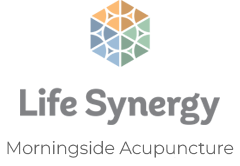A condition that we often treat in our clinics is a sore and constantly aching shoulder. This type of pain can be debilitating and can restrict your day to day activities.
The support network of muscles and tendons that surround the shoulder is called the rotator cuff and injury to this can be very painful.
Please read on to learn more about the rotator cuff and how we, as Acupuncturists, can help this condition.
What is it?
The rotator cuff is the support network of muscles and tendons that surround the shoulder joint. The primary function of the rotator cuff is to stablise the shoulder joint. Secondary to that, the function of the muscles that make up the rotator cuff is to lift and rotate the arm.
Anatomy:
The area consists of one joint, three bones, and four muscles.
| Joint | Bones | Muscles |
| Glenohumeral joint (shoulder: ball-and-socket joint) | Humerus (upper arm bone) | Supraspinatus |
| Scapula (shoulder blade) | Infraspinatus | |
| Clavicle (collar bone) | Teres minor | |
| Subscapularis |
Common injuries:
Due to the shape of the shoulder joint it is very susceptible to overuse injuries. Repetitive shoulder movement in the workplace, gym, or with sporting/ recreational activities can cause injury to the rotator cuff. This overuse or repetitive use can result in a tear to the muscle and/ or tendon, inflammation of the cushioning in the joint (bursitis), or inflammation of one or more tendons (tendinitis).
Symptoms:
Pain is the most common symptom of rotator cuff injuries. The sensation can range from being sharp and intense due to an acute injury to the shoulder, or dull and achy due to degeneration over time. The pain sensation can occur when the shoulder is in use or even at rest. You may experience a loss of strength, limited range of movement, clicking or cracking through the joint with movement or when it is in certain positions, and an inability to lie on that shoulder when sleeping due to it exacerbating the pain symptoms.
Diagnosis:
Diagnosis is usually made by physical examination and confirmed with medical imaging.
How can acupuncture help?
Acupuncture has successfully been used to treat chronic and acute musculoskeletal conditions of the shoulder. Your acupuncture treatment may consist of a combination of traditional acupuncture points, trigger points, and motor points. Electro-acupuncture, cupping, moxibustion, heat lamps, and liniments may also be used in conjunction with the acupuncture. The goal is to reduce the localised and referred pain, and increase mobility and joint functioning.
What to expect:
This is subjective to the individual, but generally, you can expect an increase in movement through the shoulder joint with a notable reduction in pain. It should be noted that chronic rotator cuff injuries will require more treatment than acute presentations; the number of treatments necessary is assessed on a case-by-case basis by your Acupuncturist.
After care:
It is recommended to keep the area warm, with the aid of liniments and/ or heat packs; whilst this will have a local analgesic affect, it will also promote healthy blood flow to the area which is conducive to healing the injury and it will help to keep the muscles in a more relaxed state. It is also recommended to rest the area whilst it is acutely inflamed, but it is not recommended to stop exercising altogether.
Exercises that strengthen the rotator cuff muscles are advised to protect the integrity of the joint, especially after an injury. Exercises can be modified to accommodate for your pain level and capabilities by a qualified physiotherapist, exercise physiologist, or personal trainer.
Reference:
Maruvada, S., Madrazo-Ibarra, A., & Varacallo, M. Anatomy, Rotator Cuff. [Updated 2020 Mar 29]. In: StatPearls [Internet]. Treasure Island (FL): StatPearls Publishing; 2020 Jan-. Available from: https://www.ncbi.nlm.nih.gov/books/NBK441844/
